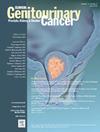Optimal Timing of Cytoreductive Nephrectomy in Metastatic Renal Cell Carcinoma Patients Considering Sarcomatoid Status: A Real-World Study
IF 2.7
3区 医学
Q3 ONCOLOGY
引用次数: 0
Abstract
Objective
To compare the outcomes of metastatic renal cell carcinoma (mRCC) patients, with or without sarcomatoid features, who underwent cytoreductive nephrectomy (CN) before or after systemic therapies (ST).
Methods
Synchronous metastatic RCC patients of IMDC intermediate- and high-risk diagnosed between January 2011 to December 2022, treated with CN before or after ST, and with histological documentation of the presence or absence of sarcomatoid features in nephrectomy specimens were identified using the Canadian Kidney Cancer information system (CKCis). Patients were classified by treatment sequence received: (1) CN after ST (2) CN before ST. Inverse probability of treatment weighting using propensity scores was used to balance for covariates. Cox proportional hazards models were used to assess the impact of initial treatment received on overall survival (OS).
Results
Of 709 eligible patients, 105 were treated with CN after ST and 604 with CN before ST. 75% were male, and the majority (70%) received targeted therapies (TT) used alone. In nonsarcomatoid patients (80 CN after ST and 454 CN before ST), treatment with CN after ST was associated with an improvement in OS, that was not statistically significant, compared to CN before ST (median of 60 vs. 48 months, HR 0.84, 95% CI 0.64-1.11). In sarcomatoid patients (25 CN after ST and 150 CN before ST), CN after ST was also not associated with better survival (median of 24 vs. 36 months, HR 1.10, 95% CI 0.70-1.73).
Conclusion
In conclusion, this study demonstrated that, no matter the sarcomatoid status, there is no statistical difference between receiving CN after ST or CN before ST. The timing of CN could potentially be linked more so to clinical assessments than the knowledge of sarcomatoid status.
考虑到肉瘤样状态的转移性肾细胞癌患者的最佳切除时间:一项真实世界的研究
目的比较有或无肉瘤样特征的转移性肾细胞癌(mRCC)患者在全身治疗(ST)前后行细胞减减性肾切除术(CN)的预后。方法使用加拿大肾癌信息系统(CKCis)对2011年1月至2022年12月期间诊断为IMDC中高风险的同步转移性RCC患者进行鉴定,这些患者在ST之前或之后接受过CN治疗,并且在肾切除术标本中存在或不存在肉瘤样特征的组织学记录。根据接受的治疗顺序对患者进行分类:(1)ST后CN (2) ST前CN,使用倾向评分的治疗加权逆概率来平衡协变量。采用Cox比例风险模型评估初始治疗对总生存期(OS)的影响。结果709例符合条件的患者中,有105例ST后合并合并CN, 604例ST前合并合并CN, 75%为男性,大多数(70%)接受单独靶向治疗(TT)。在非肉瘤样患者(ST后80 CN和ST前454 CN)中,与ST前CN相比,ST后CN治疗与OS改善相关,但无统计学意义(中位数为60个月vs 48个月,HR 0.84, 95% CI 0.64-1.11)。在肉瘤样患者(ST后25个CN和ST前150个CN)中,ST后CN也与更好的生存无关(中位数为24个月vs 36个月,HR 1.10, 95% CI 0.70-1.73)。总之,本研究表明,无论是否为肉瘤样状态,ST后或ST前接受CN均无统计学差异。CN的时机可能与临床评估的关系大于对肉瘤样状态的了解。
本文章由计算机程序翻译,如有差异,请以英文原文为准。
求助全文
约1分钟内获得全文
求助全文
来源期刊

Clinical genitourinary cancer
医学-泌尿学与肾脏学
CiteScore
5.20
自引率
6.20%
发文量
201
审稿时长
54 days
期刊介绍:
Clinical Genitourinary Cancer is a peer-reviewed journal that publishes original articles describing various aspects of clinical and translational research in genitourinary cancers. Clinical Genitourinary Cancer is devoted to articles on detection, diagnosis, prevention, and treatment of genitourinary cancers. The main emphasis is on recent scientific developments in all areas related to genitourinary malignancies. Specific areas of interest include clinical research and mechanistic approaches; drug sensitivity and resistance; gene and antisense therapy; pathology, markers, and prognostic indicators; chemoprevention strategies; multimodality therapy; and integration of various approaches.
 求助内容:
求助内容: 应助结果提醒方式:
应助结果提醒方式:


